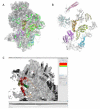Gorgon and pathwalking: macromolecular modeling tools for subnanometer resolution density maps
- PMID: 22696403
- PMCID: PMC3899894
- DOI: 10.1002/bip.22065
Gorgon and pathwalking: macromolecular modeling tools for subnanometer resolution density maps
Abstract
The complex interplay of proteins and other molecules, often in the form of large transitory assemblies, are critical to cellular function. Today, X-ray crystallography and electron cryo-microscopy (cryo-EM) are routinely used to image these macromolecular complexes, though often at limited resolutions. Despite the rapidly growing number of macromolecular structures, few tools exist for modeling and annotating structures in the range of 3-10 Å resolution. To address this need, we have developed a number of utilities specifically targeting subnanometer resolution density maps. As part of the 2010 Cryo-EM Modeling Challenge, we demonstrated two of our latest de novo modeling tools, Pathwalking and Gorgon, as well as a tool for secondary structure identification (SSEHunter) and a new rigid-body/flexible fitting tool in Gorgon. In total, we submitted 30 structural models from ten different subnanometer resolution data sets in four of the six challenge categories. Each of our utlities produced accurate structural models and annotations across the various density maps. In the end, the utilities that we present here offer users a robust toolkit for analyzing and modeling protein structure in macromolecular assemblies at non-atomic resolutions.
Copyright © 2012 Wiley Periodicals, Inc.
Figures






References
Publication types
MeSH terms
Substances
Grants and funding
LinkOut - more resources
Full Text Sources
Research Materials

